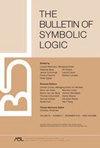可计算可枚举度的层次结构
IF 1.1
3区 数学
Q1 LOGIC
引用次数: 4
摘要
我们引入了一种新的可计算枚举度的层次结构。这个层次是基于测量∆2函数近似复杂度的可计算有序符号。在可计算理论中,层次结构统一和分类了许多不同结构的组合。它按照高度数(Martin)和数组不可计算度数(Downey, Jocksuch和Stob)的顺序进行操作。层次结构还给出了一些自然的可定义性结果,包括一个可定义的本文章由计算机程序翻译,如有差异,请以英文原文为准。
A Hierarchy of computably Enumerable Degrees
We introduce a new hierarchy of computably enumerable degrees. This hierarchy is based on computable ordinal notations measuring complexity of approximation of ∆2 functions. The hierarchy unifies and classifies the combinatorics of a number of diverse constructions in computability theory. It does so along the lines of the high degrees (Martin) and the array noncomputable degrees (Downey, Jocksuch and Stob). The hierarchy also gives a number of natural definability results in the c.e. degrees, including a definable
求助全文
通过发布文献求助,成功后即可免费获取论文全文。
去求助
来源期刊
CiteScore
0.60
自引率
0.00%
发文量
32
审稿时长
>12 weeks
期刊介绍:
The Bulletin of Symbolic Logic was established in 1995 by the Association for Symbolic Logic to provide a journal of high standards that would be both accessible and of interest to as wide an audience as possible. It is designed to cover all areas within the purview of the ASL: mathematical logic and its applications, philosophical and non-classical logic and its applications, history and philosophy of logic, and philosophy and methodology of mathematics.

 求助内容:
求助内容: 应助结果提醒方式:
应助结果提醒方式:


